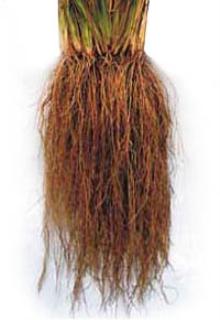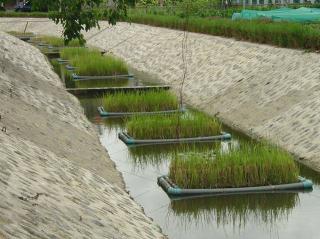
What is Vetiver?
Vetiver Grass and the Vetiver System

Vetiver grass is a tropical plant which can well adapt to different environmental conditions, from highlands to lowlands. Presently, the utilization of vetiver is known as the Vetiver System (VS) standing for a low-cost, simple technology employing live vetiver plant for soil and water conservation and environmental protection. VS is a very practical, inexpensive, low maintenance and very effective means of soil erosion and sediment control, water conservation, and land stabilization and rehabilitation. Being vegetative, it is also environmentally friendly.
The technology was first developed for the agricultural section by the World Bank for soil and water conservation, and later expanded to cover non-agricultural sector through bioengineering and phytoremediation for environmental protection such as slope and embankment stabilization, reclamation of wasteland, rehabilitation of contaminated land, water purification, pollution control, prevention or mitigation of natural disaster, etc.
Vetiver's Unique Properties: Its Uses and Utilization
Unique Root System: With its extensive fibrous root system which penetrates deep down into the soil at great depth. Its roots were found to break through hardpan as thick as 15 cm. They were also found to have 'innate' power to penetrate a fairly thick layer of asphatic concrete. On slopes underlain with weathered rock, boulders or relatively hard layer, its penetrating roots will provide anchorage by root tendron action. Its action is comparable to a nail which could penetrate deep layers of soils whose texture may be quite hard, and at the same time it has the ability to hold soil particles together through its extensive fibrous roots, thus avoiding soil erosion due wind and water, making it well known among road engineers as the 'living nail'.



Unique Clumps when Grown as Hedgerows: The act of its clumps which are able to slow down the rapid movement of water and wind is really amazing. The direct benefits of this 'living wall' or 'living barrier' are: (i) increasing organic matter and moisture in front of the hedgerows, and (ii) acting as a sieve, and not allowing any debris to pass through but to accumulate in front of the hedgerow.


Unique Living Dam: The act of both the roots and clumps as a 'living dam' is also amazing. Their direct benefits are as follows: (i) adhere soil particles thus reducing soil erosion, (ii) increase the amount of organic matter collected in front of the hedgerow, (iii) increase moisture content in front of the hedgerow as the result of accumulation of organic matter and water, (iv) filter out toxic substances brought in by water and, after being absorbed in the plant tissues (see its tolerance later), these will slowly disintegrated, while clear and clean water is able to pass through this living dam.



Tolerance to a Wide Range of Environmental Stresses: The Vetiver System (VS) was first developed for soil and water conservation on the farmlands. While this application still plays a vital role in agricultural lands, vetiver's unique morphological, physiological and ecological characteristics, including its tolerance to highly adverse conditions, has played a key role in the area of environmental protection and land rehabilitation. These include tolerance to the following adverse conditions: (i) acidity, manganese and aluminum, (ii) salinity and sodality, and (iii) heavy metals like arsenic, cadmium, copper, chromium, lead, mercury, nickel, selenium and zinc.
Ability to Absorb Toxic Substances: Not only vetiver can tolerate adverse soil conditions, but it can absorb toxic substances like pollutants, pesticides, and heavy metals into its biomass, thereby diluting such toxic substances in the soils and water, making them safer in agricultural and non-agricultural activities. One such activity is the use of vetiver to purify eutrophicated water in the lake, leachate from garbage landfill, etc. It can also be used to absorb heavy metals from quarry, and such valuable metals can be recycled by extraction from the vetiver biomass.


Increase income through Vetiver Handicrafts: The utilization of leaves plays a complementary role in growing vetiver for soil and water conservation purposes since the leaves are normally cut off at regular intervals to stimulate its growth. Such cut leaves can be utilized as roof thatching or in making handicrafts as a supplementary occupation to earn extra income.








